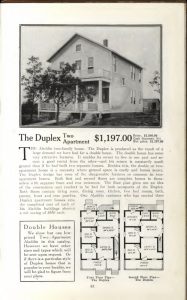Like Taylor Swift, Duplexes Have Eras

Aladdin kit homes duplex plans
Early next year, I will be teaching a Realtor’s continuing education class on duplexes. It’s caused me to spend a lot of time doing my favorite thing; research.
Of course, none of my friends or family are interested in what I’ve learned. However, since readers of this blog and newsletter likely also share at least some of my interest, I thought I’d offer some of it here.
It turns out duplexes have been around hundreds, if not thousand of years longer than I thought. And it also turns out they have always been a means to create long-term wealth for owner-occupant investors.
1) Pre-1900’s – Ancient & Medieval Precedents: In Rome, insulae (multi-story apartment blocks) sometimes housed extended families in paired units. In medieval Europe, side-by-side dwellings for workers or kin were common in walled towns. In 18th–19th Century America: Colonial America, think cities with ports like Philadelphia, Boston, and Charleston saw the construction of brick, mirror-image homes for extended families or rental income.
In this era, duplexes were used to house extended families, servants, or workers close to were jobs were. They also provided an economical use of the land and an opportunity to share things like heat and a chimney stack.
2) Urban stacked “two-flats” (late 19th–early 20th century)
The industrial revolution at the end of the 19th century created an incredible number of jobs. Massive numbers of workers were needed to work in factories, mills, and the retail and service industries that sprung up around them. The stacked two-flat or up/down duplex (one apartment per floor) became a defining urban housing type in industrial cities. They helped fill huge demand for worker housing and created owner-landlord upward mobility opportunities.
3) Golden age of kit homes — Aladdin, Wardway, Sears (1900–1940)
While overlapping with the second era, this period is distinctive in that mail-order kit companies sold complete plans and pre-cut materials to build duplexes. While all of the major companies that offered kits focused on single-family, some duplex/two-flat models (Aladdin’s 1916 catalog explicitly includes a model called “The Duplex”; Wardway and Sears also advertised two-family plans). Kit duplexes let small owners and employers quickly build rental housing and worker cottages across the U.S. — think “live in one unit, rent the other.”
4) Post-war suburban boom and decline of duplex construction (1945–1970)
After WWII, mortgages and culture preferences favored single-family suburban tracts. Lots got bigger, and zoning regulations changed. Cars allowed people to live further out from the urban core and commute to work. Instead of being interspersed with single-family homes, multi-family properties were frequently assigned their own neighborhood. Duplex construction slowed in many suburbs though duplexes and small multi-unit buildings persisted near colleges, and in first ring suburbs, which were had greater density than those further out.
These regulatory and cultural shifts resulted in duplexes being less common.
5) Zoning era and “grandfathered” duplexes (1970s–1990s)
Many duplexes remained legal as existing uses in single-family zones, but new construction was often prohibited. This era cemented the pattern of duplexes being concentrated in older urban neighborhoods and a few permissive college towns. Austin , Texas, is one city where the presence of universities and a growing tech sector created a need.
6) Modern revival & “missing-middle” / upzoning (2000s–present)
Rising housing costs and affordability crises revived interest in duplexes and helped spawn terms like “house hacking”. An urgent need for more housing has helped prompt policy changes. Here in Minneapolis, the 2040 plan is a great example of this. Here, and in other and similar cities zoning and policy changes now allow Accessory Dwelling Units (ADU’s), duplexes, and triplexes citywide. Most new construction since the Minneapolis reforms has been larger multi-unit buildings on corridors rather than small duplex builds.
7) Contemporary architecture & infill duplexes (2010s–2020s)
While most of the new construction as part of Minneapolis’ 2040 plan has come in the form of large apartment buildings, new duplexes have been built. Here and across the nation, these modern designs range from historic renovations to sleek, narrow modern duplexes built for tiny urban lots. These projects often emphasize energy efficiency, higher-end finishes (for resale to owner-occupiers/investors).
Isn’t incredible that throughout history, duplexes have served the same purposes over and over again; building long-term welath for owner occupants and investors alike.
If you’d like to get started making your own duplex history, give me a call. There are few things more rewarding than helping someone change the course of their future and generations to come.

